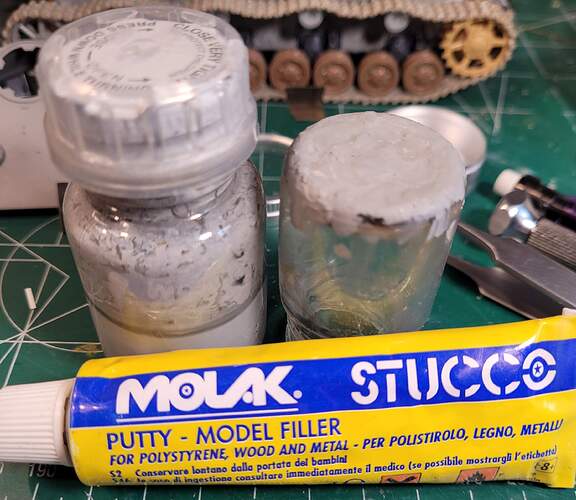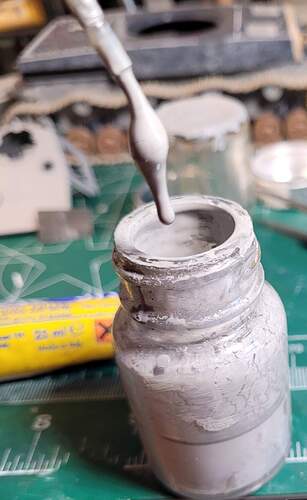Not sure if this is the right spot for this, but it sounded closest to being logical. Been using Squadron Green Putty for decades. Usually order it off evilbay … tends to be a bit cheaper. All that’s on there is White and Gray putty. Looked it up on Squadron’s site and the description is the same for all 3 putties. Is there any difference between them, other than color?
Texture, drying time, and shrinkage are different for all three. Don’t ask me which one is which, though.
Thanks. Guess I’ll have to go straight to the horse (wont say which end) and order some green (know how that behaves) from Squadron.
The white putty is smoother… IIRC. I use the very thin CA glue to coat the putty once it’s fully shaped and sanded to give it a tougher/smoother surface.
@sluff Timothy, please accept this comment with the understanding its meant to be helpful.
The Squadron putty can be used successfully - usually after being filled with thin super glue as mentioned above.
My experience with Squadron white & Green putty is almost completely negative. My issues with filling seams properly disappeared after pitching Squadron putty.
Back in the early 90’s, two friends both outstanding modelers that regularly placed in the IPMS Nationals, explained the issues with Squadron: grainy, poor adhering, porous, shrinking & slow curing. Squadron might be OK for making sand bags or Zimmerit. These two were among the very best modelers I’ve known.
I took their advice and ditched Squadron putty. No more seams issues after moving to epoxy putty or super glue & accelerator. That one prduct change improved my model builds more than any other single product change.
Later found Molak Stucco and Tamiya Basic Gray for basic putty work. Both excellent products. For nasty seams its hard to beat super glue & accelerator.
For tube putty, the easy to find Tamiya Basic Gray is hard to beat. I have no experience with Squadron gray and can’t comment on it.
Wish you the best with your modeling.
My last tube of green that I bought off the shelf about 8 months ago had severe separation issues right out of the tube. It ended up being a complete waste and unworkable. The top half of the tube was more of a light green slurry bordering on translucent. When I got to the “green” stuff it had a consistency and heavy grainy texture that reminded me of wood putty and it clumped up and peeled back horribly as I worked it into the seams I was addressing. The LHS replaced it for me and same results so maybe just a bad batch but twice bitten. I do have the a grey tube that was fine but in the interim I switched to Tamiya’s basic and also found some Vallejo which I do like working with, shrinking was minimal and easy to work while ‘wet’ and with a dab of water on my finger or tool to smooth it out and excess was easy to remove. I think modern chemistry has regulated Squadron’s green to a fond memory for me.
I ditched putty completely many years ago. Some Verlinden stuff that wore out my files before I could file it down to the wanted shape.
For filling seams I use thin strips of styrene if I haven’t been able to fix the issue before assembly (dry fit, check, modify, dry fit again, rinse and repeat until it fits)
Personally for filling I use a mix of Metallic pigments and CA glue, I found that using regular pigments wont sand as well. It works well for small gaps but for larger ones I would do what Robin does. 
For narrow/small gaps I use styrene shims down to 0.2 or 0.1 mm …
I haven’t bought a tube of Squadron green putty in years.
I use 4 different methods depending on what I think will work in different situations. I bought a big tube of automotive red putty.
I like CA glue but don’t have any accelerator (got to try that someday).
I like Vallejo acrylic putty for small, narrow gaps.
For larger straight work I like strip styrene.
Take care and stay safe friends,
Don “Lakota”
I use Bondo Spot Putty. I swear by it. It adheres to styrene, resin, and photo etch and does not shrink at all. Sands easily to a glass finish. The best putty out of any you can use, bar none. $6 for a ten year supply.
Intresting that this topic comes up, I used Geen Stuff for years then switched to Tamiya gray with basically the same results. Like most I’ll use stretched sprue and styrene glue to fill gaps (stretched sprue drenched in glue and dimpled with a knife point makes a decent “weld bead”), the problem I have with putties is application, even using a scale size putty knife it doesn’t lay in like I want it to, for example filling punch outs or sinks the putty tends to roll rather than spread, I’ve yet to find a suitable thinning agent to make it more workable. I might try the Bondo routine but I’ll still need to find a cleaning agent.
Cajun
Get a punch-and-die set and punch out little styrene disks to fill ejector pin marks
It’s a thought. Man, 6 one way or half a dozen the other.
Cajun
I have heard you can thin Tamiya putty with lacquer thinner or Tamiya cement.
Even if you can’t get the perfect size of disk to fit the hole it will be easier to fill the remaining gap with CA and sand smooth than fighting the putty …
Often times the sprue itself (or at least parts of it) is the same diameter as the ejection marks, so I just shave off a bunch of discs until I get some that are perfect.
Bondo Spot Putty won’t roll on you; it sticks to the surface and spreads easily. It’s creamy and can be pressed into cracks. It doesn’t need to be thinned. If the Bondo is too bulky for a job, then Mr. Surfacer 500 takes over.
Ryan, FWIW
Tamiya Basic Gray thins very nicely with old slow original Testor’s Liquid Cement.
Molak Stucco thins amazing fine withTestor’s old slow original Liquid Cement. Thins out nicely like paint if one wishes. I almost never reach for Mr. Surfacer since Molak Stucco is so flexible when thinned. The bottle of thinned Stucco is probably one of the most used items on my desk. 
Of course both shrink being putty or thinned putty
@Tank_1812 I use Tamiya cement (green bottle top) for thinning putty when I add a cast finish to armor models. I just stipple the putty on with an old paintbrush and toothpick. I then sand to the desired smoothness.
The thing to remember is to prime over the putty when you’ve completed the cast metal texture. Otherwise the red putty I use will show through and is hard to eliminate with your basecoat of paint.
Take care and stay safe friends,
Don “Lakota”


